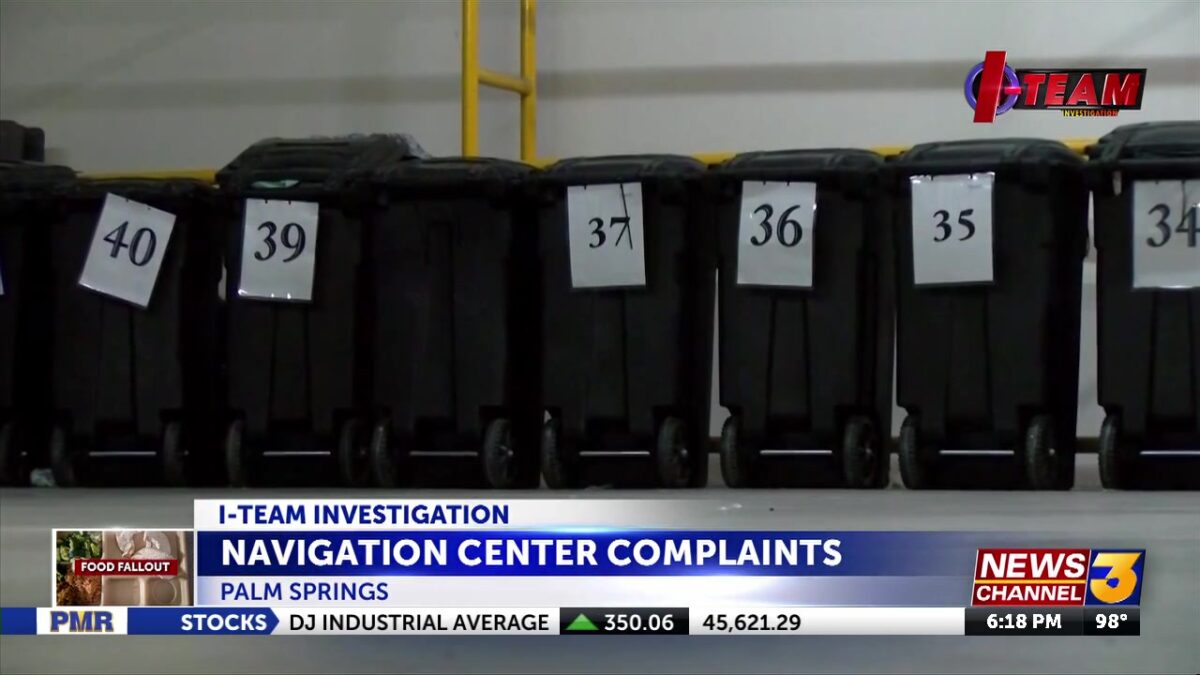I-Team: Clients complain about Navigation Center’s food, rules, and cleanliness

Jeff Stahl
PALM SPRINGS, Calif. (KESQ) – The Palm Springs Navigation Center has been a game-changer in reducing the city’s unsheltered population, and by most accounts, city leaders say it’s proven itself in getting people off the streets and connected with resources to get them back into housing.
However, in an I-Team investigation, some individuals receiving help at the Navigation Center have expressed complaints, including that some of its meals are inedible, some of the rules are overbearing and unnecessary, and they have concerns about the center’s overall cleanliness.
Palm Springs leaders credit the Navigation Center for a 63 percent drop in unsheltered people in the city and a 155 percent jump in those who now have a roof over their heads. Those numbers are from the latest Point In Time homeless count.
“I’ve had food poisoning four out of five months,” said client John Corliss. “I’ve gone through four boxes of Imodium A.D. since I’ve been here,” Corliss added.
A Navigation Center client, Kimberly Glassco, said, “The food is really, really bad, unfortunately. And it’s the same all the time.”
Photos that other clients sent us show food trays of what they claim are over-seasoned, high-sugar foods and undercooked meats.
Jeff Stahl asked another client, Dino Negron, “What have you experienced?” Negron said, “Getting sick, A lot of things, the cleanliness of everything is bad.”
Jeff Stahl asked Negron’s wife, Shannon, the same question, “Have you ever gotten sick?” Shannon responded, “Yes, I have been sick six times.”
Under the shade of a tree in front of City Hall on a summer day with temperatures well above 100 degrees, Jeff Stahl listened, and Navigation Center clients shared photos of recent meals served and photos of all the food thrown out. They say it’s because the food is inedible. And they say they’ve been told the center has no food budget.
I wanted answers from Ann Eiring, the Navigation Center’s Project Manager. Martha’s Village operates it. As for food quality? Eiring said, “I eat lunch here every day.”
Eiring says there is a food budget. But it’s not unlimited.
“There is a repeating of the menu,” Eiring said, adding, “but it’s every three weeks.”
Eiring says they do their best to accommodate dietary needs, vegetarian preferences, and religious beliefs. She insists they serve a variety of foods. “We work with our kitchen manager to make sure we are nutritionally sound and making sure each meal has vegetables. They’re usually fresh vegetables, not frozen; they’re steamed in the kitchen. Everything is prepared there from scratch,” Eiring said.
We examined the Navigation Center’s budget for its current Phase 3 shelter operations.
It includes $200 thousand for food purchases, another $40 thousand for food snacks, and nearly $400 thousand for cooks, helpers, a kitchen supervisor, and a manager.
Clients also say the rules are often overbearing. They say they have to sit down or get kicked out of the Access Center, a day Center off El Cielo in an old Boxing gym south of city hall. There’s no charging phones in wall outlets and no purses allowed, clients say.
Kimberly Glassco said, “I take mine out to my car, but you have to lock your purse up. You can’t have it in there, which is really dumb.”
Eiring responded, “But it’s mostly just for safety.” “We don’t– if they need their ID, their money, whatever, they can hold that on themselves,” Eiring added.
When it comes to phones, Eiring said they don’t want to overload the center’s power circuits but do offer numerous phone charging stations. As for the clients forced to sit? “The sitting down is mostly for safety,” Eiring said, adding, “because if people were up and moving around, it would be chaos.”
There are more complaints. Take a look at these photos of trash cans used to store people’s personal belongings.
A client who asked us only to use his first name, Dominick, said, “That’s like psychological warfare. Telling us your stuff is trash.”
Eiring says the cans are a model taken from another L-A shelter. She says they are more durable, easier to clean, and, for the client’s benefit, they offer more space than traditional bins. “It’s been working,” Eiring said, adding, “I understand that it may feel degrading. We’re not trying to say your belongings are trash by any means, but it’s just what works best.”
And then there’s a long-clogged men’s toilet. A sign has been up for months now, saying ‘out of order.’ “That is something that’s ongoing,” Eiring said, adding, “I want to be transparent. We are trying to address it.”
Eiring says a construction defect means a toilet is not properly aligned with its plumbing. They’re working with the city to make repairs, but it won’t be easy.
Overall, Eiring says staff are doing the best they can within the city’s budget, and they welcome feedback.
“We have a system called ‘report to staff,'” Eiring said, adding, “They can give us their feedback. They can escalate it to management if they’re not getting an answer.”
Clients say they ultimately want better food, some respect, and better accountability.